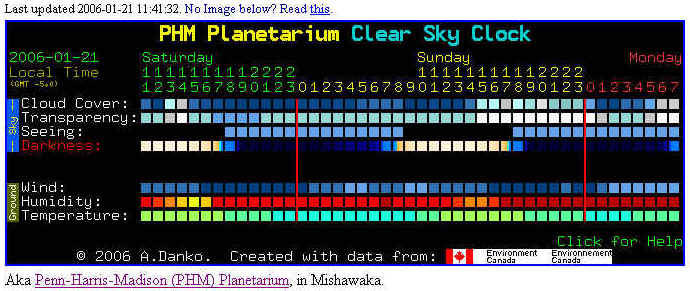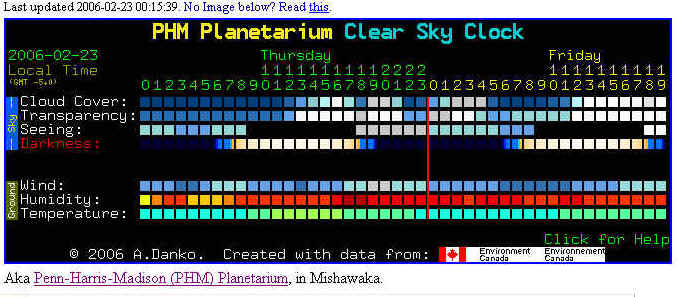SQM Data
Sky Quality Meter (SQM) correlated with Clear Sky Clock.
Clear Sky Clock courtesy of Attilla Danko; used with permission.
| SQM readings from back porch post. 06-01-22, 12:15 a.m. EST, clear skies.
|
 |
| SQM readings from back porch post. 06-01-23, 9:28 p.m.EST, clear skies. [Note: CSC midnight red bar was copied hours after actual 9:28 p.m. SQM reading.]
|
 |
| SQM readings from back porch post. 06-02-21, 11:50 p.m. EST, clear skies. Average=18.74
|
(No Clear Sky Clock data.) |
| SQM readings from back porch post. 06-02-23, 2:27 a.m. EST, clear skies.
|
 |
Prairie Vista baseball field 06-03-19, 8:41 p.m. EST clear skies; ave.=18.69
|
| SQM readings from back porch post. 06-03-21 9:30 p.m. EST, clear skies.
|
From the PHM Clear Sky Clock at http://cleardarksky.com/c/PnnHrMPINkey.html:
It is based on Ben Sugarman's Limiting Magnitude calculations page. It takes into account the sun's and moon's position, moon phase, solar cycle and contains a scattering model of the atmosphere. It doesn't consider light pollution, dust, clouds, snow cover or the observer's visual acuity. So your actual limiting magnitude will often be different. |
A. Danko, creator of the Clear Sky Clock, writes:
"Accurate SQM readings should be had only when the clock's darkness line reads 6.0...The darkness line calculates a theoretical sky brightness that does not consider light pollution. But it does consider the phase of the moon, altitude of the moon and altitude of the sun...It clearly shows that even a gibbous moon can have very little effect when it is at only a few degrees altitude. The altitude at which a given phase of the moon affects the brightness at zenith varies in a complex way which the darkness model takes into account...While the 6.0 number the "darkness" line calculates for a sky free of scattered moonlight and sunlight is not quite right (mostly because vision varies hugely from person to person), it's a very good indication of when the sky will be at minimum brightness from light from the sun and moon." ( Copyright ©2006 A. Danko; used with permission.)
OTHER:
- Eleven SQMs with sequential serial numbers are correlated with Clear Sky Clocks at common sites at sqm11.htm.
- SQM readings from June 2006 are underway at sqm2006june.htm.
- "Suburb back yard, IN" readings, taken from Granger, IN, near Gumwood Rd. and Adams Rd., are tallied at the SQM Database
- SQM readings from Brendon Hills Park, off Gumwood Rd. north of Cleveland Rd. in St. Joseph County, Indiana, are at gumwood.htm.
- SQM readings from Carmel H.S. Planetarium, with a new GOTO Chronos starfield at full brightness, stars to visual magnitude 6.5, and the Milky Way at/near the horizon, indicated an average level of nearly 23.0 magnitudes per arcsecond squared, which is darker than the darkest natural sky; March 2006.